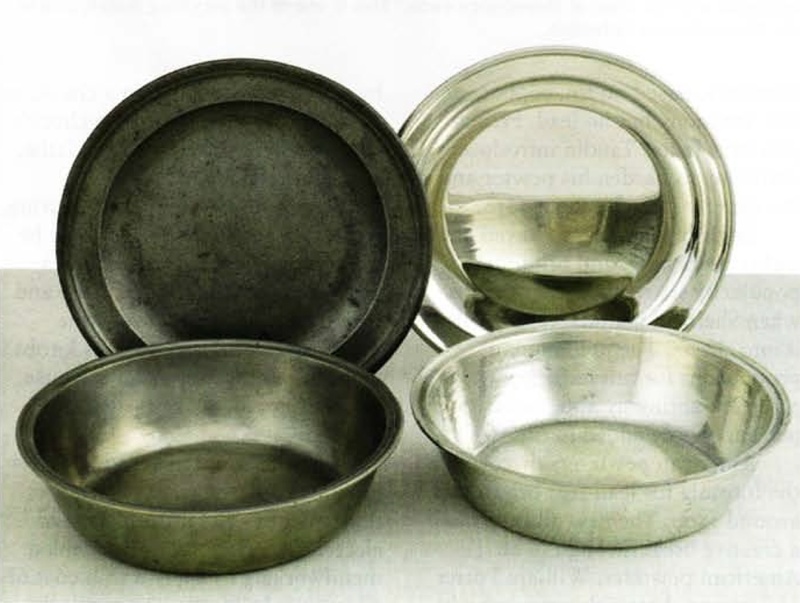The Early American Kitchen, Inspiration
As we have seen in other rooms, there are also subtle historical nods to be discovered in here if one looks hard enough!
One newspaper clipping Mrs. Fisher captured points out the reminiscent feel of pilgrim living found within the Early American Kitchen:
The hand-hewn cupboard, its shelves neatly lined with those pewter cutlery and wooden bowls, act as a nod to the limited but attended household goods of the period.
Pewter, as the newspaper is quick to note, is a staple inclusion for the style, as it was popular during English 18th century society for its durability and affordability compared with other metals, like silver. It was also better melted down when the pieces were spent and recast into new tableware.
Yet, that would shift in the colonies, as historical fiction writer, Gregory Lefever, addressed in his article in Early American Life:
Perhaps that is why only the silverware is pewter within the room, while the remainder appear to be earthen wares and wood. Lefever mentions that pewter would be used as a symbol statement in the colonies:
"It demonstrated that the owner could afford better than wooden tableware at a time when a single pewter plate might cost what a skilled craftsman earned in a day."
These attentions highlight the history during the period while the warmer aspects---beamed ceilings and warm pine paneling---invite us to reflect on the daily rhythms and quiet resilience of the early settlers. It is a tribute to the power of small things. Not just the scale of them, but the stories she created with them!
But wait until you see where Mrs. Fisher and her Dollhouse went!
![<a href="/omeka/items/browse?advanced%5B0%5D%5Belement_id%5D=50&advanced%5B0%5D%5Btype%5D=is+exactly&advanced%5B0%5D%5Bterms%5D=A+Zoom+of+a+Newspaper+Article+entitled%2C+%E2%80%9CA+Hobbyist+with+a+Heart%2C%E2%80%9D+Introducing+Mrs.+Fisher%27s+Early+American+Kitchen%2C+%5Bca.+1950s-1960s%5D">A Zoom of a Newspaper Article entitled, “A Hobbyist with a Heart,” Introducing Mrs. Fisher's Early American Kitchen, [ca. 1950s-1960s]</a> <a href="/omeka/items/browse?advanced%5B0%5D%5Belement_id%5D=50&advanced%5B0%5D%5Btype%5D=is+exactly&advanced%5B0%5D%5Bterms%5D=A+Zoom+of+a+Newspaper+Article+entitled%2C+%E2%80%9CA+Hobbyist+with+a+Heart%2C%E2%80%9D+Introducing+Mrs.+Fisher%27s+Early+American+Kitchen%2C+%5Bca.+1950s-1960s%5D">A Zoom of a Newspaper Article entitled, “A Hobbyist with a Heart,” Introducing Mrs. Fisher's Early American Kitchen, [ca. 1950s-1960s]</a>](https://omeka.wilkes.edu/omeka/files/fullsize/45dbb7f57d5527d2c5ce7cc4b17c3d79.jpg)
![<a href="/omeka/items/browse?advanced%5B0%5D%5Belement_id%5D=50&advanced%5B0%5D%5Btype%5D=is+exactly&advanced%5B0%5D%5Bterms%5D=A+Photograph+of+the+Hutch%2C+created+by+Mrs.+Fisher%2C+%5Bca.+1950s-1960s%5D">A Photograph of the Hutch, created by Mrs. Fisher, [ca. 1950s-1960s]</a> <a href="/omeka/items/browse?advanced%5B0%5D%5Belement_id%5D=50&advanced%5B0%5D%5Btype%5D=is+exactly&advanced%5B0%5D%5Bterms%5D=A+Photograph+of+the+Hutch%2C+created+by+Mrs.+Fisher%2C+%5Bca.+1950s-1960s%5D">A Photograph of the Hutch, created by Mrs. Fisher, [ca. 1950s-1960s]</a>](https://omeka.wilkes.edu/omeka/files/fullsize/4998374e882f58e893cb8b569f5869e3.jpg)

![<a href="/omeka/items/browse?advanced%5B0%5D%5Belement_id%5D=50&advanced%5B0%5D%5Btype%5D=is+exactly&advanced%5B0%5D%5Bterms%5D=A+Set+of+Pewter+Spoon+Casts%2C+created+by+Unknown%2C+Sourced+from+the+ASL+Pewter%2C+%5Bca.+18th+century%5D%2C+sourced+from+Early+American+Life%2C+author+Gregory+Lefever%2C+2007+December.">A Set of Pewter Spoon Casts, created by Unknown, Sourced from the ASL Pewter, [ca. 18th century], sourced from Early American Life, author Gregory Lefever, 2007 December.</a> <a href="/omeka/items/browse?advanced%5B0%5D%5Belement_id%5D=50&advanced%5B0%5D%5Btype%5D=is+exactly&advanced%5B0%5D%5Bterms%5D=A+Set+of+Pewter+Spoon+Casts%2C+created+by+Unknown%2C+Sourced+from+the+ASL+Pewter%2C+%5Bca.+18th+century%5D%2C+sourced+from+Early+American+Life%2C+author+Gregory+Lefever%2C+2007+December.">A Set of Pewter Spoon Casts, created by Unknown, Sourced from the ASL Pewter, [ca. 18th century], sourced from Early American Life, author Gregory Lefever, 2007 December.</a>](https://omeka.wilkes.edu/omeka/files/fullsize/4095c412e3580d931b44f519b185ba8d.jpg)
![<a href="/omeka/items/browse?advanced%5B0%5D%5Belement_id%5D=50&advanced%5B0%5D%5Btype%5D=is+exactly&advanced%5B0%5D%5Bterms%5D=A+Photograph+of+Pewter+Spoon+in+Mrs.+Fisher%27s+Early+American+Room%2C+%5Bca.+1950s-1960s%5D">A Photograph of Pewter Spoon in Mrs. Fisher's Early American Room, [ca. 1950s-1960s]</a> <a href="/omeka/items/browse?advanced%5B0%5D%5Belement_id%5D=50&advanced%5B0%5D%5Btype%5D=is+exactly&advanced%5B0%5D%5Bterms%5D=A+Photograph+of+Pewter+Spoon+in+Mrs.+Fisher%27s+Early+American+Room%2C+%5Bca.+1950s-1960s%5D">A Photograph of Pewter Spoon in Mrs. Fisher's Early American Room, [ca. 1950s-1960s]</a>](https://omeka.wilkes.edu/omeka/files/fullsize/71a8617e550b45f56a5355ca4605532e.jpg)